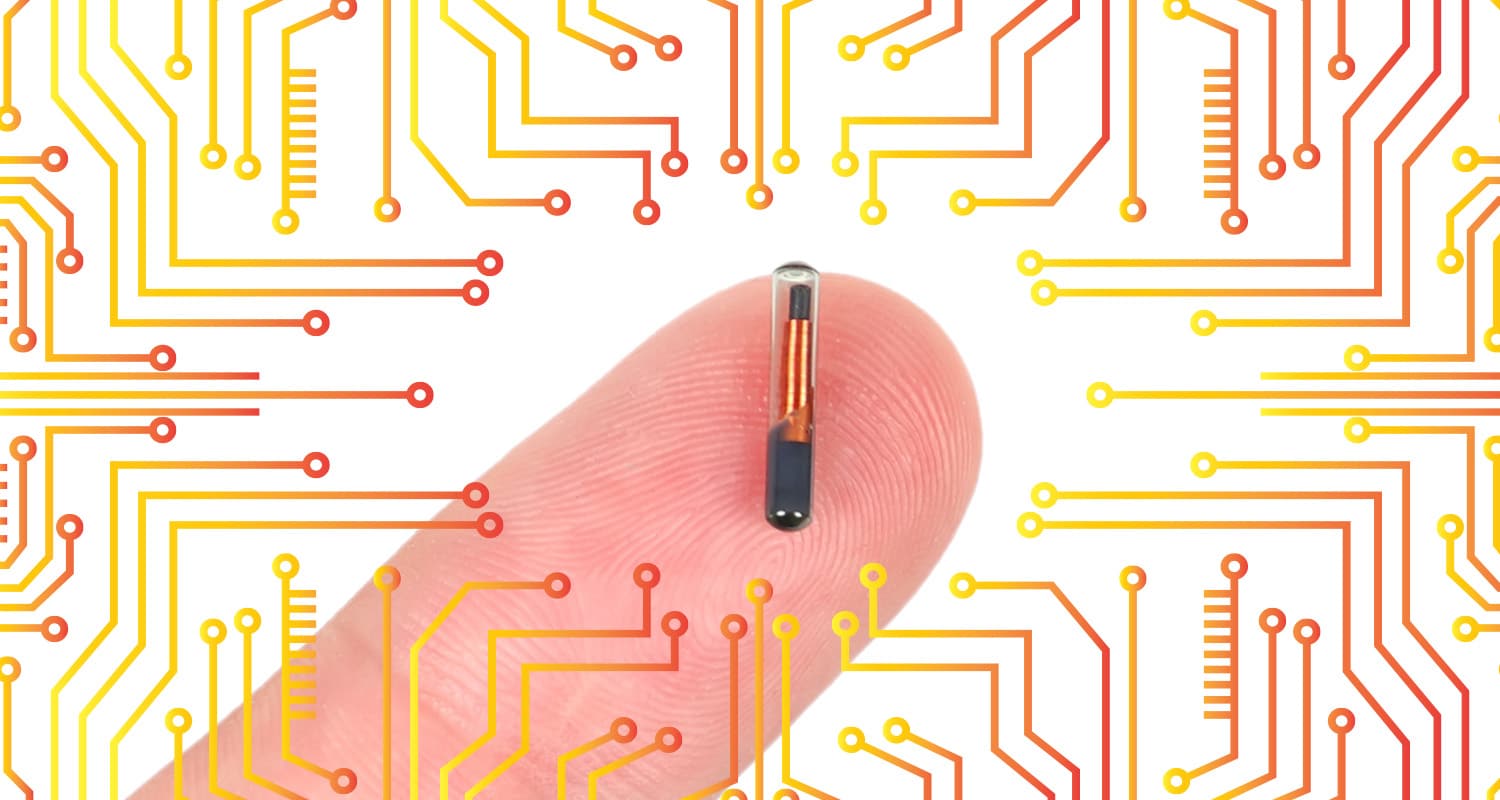
- People are installing RFID chips into their hands to open doors, store contact information, and pay for goods.
- It sounds sci-fi, but this is the same technology that you use when you microchip your pet or use a wireless key card.
- The problem? It’s too early to tell whether this technology is safe for humans. There are privacy concerns in the short-term — and serious questions about toxicity in the long-run.
- Unless you want to be a human guinea pig, science says you can (safely) biohack your way to a better you by improving your diet and sleep.
Thousands of people in Sweden are adopting microchip technology that puts the convenience of a credit card in their hands — literally.
Every time you use a key card to open a door or swipe your credit card, you use RFID (radio frequency identification) technology. It’s a ubiquitous and convenient part of everyday life. But what if you could leave your keys at home and ditch your card altogether?
NPR reports that more than 4,000 Swedes have implanted RFID chips into their hands. It’s an idea that’s gaining steam in other parts of the world, including the US. In 2017, Wisconsin-based vending machine company Three Square Market made headlines when 50 employees voluntarily opted to install microchips into their left hands.
Microchipping is also a topic of interest in biohacking circles, including the Biohackers subreddit and Biohack.me.
Right now, the chips can perform basic tasks like storing emergency contact details, opening office doors, and storing e-tickets for events. Someday soon, they may help lost children find their way home and notify your doctor if you’re at risk of heart attack.
But are implantable microchips truly safe for your health, your privacy, and your future?
What are RFID chips?
Almost any device that communicates wirelessly uses RF (radio frequency) technology. When people think about implantable RFID chips, they’re generally referring to a microchip encased in a small bioglass tube.
Picture a long grain of rice. Now, imagine that grain of rice inserted into the top of your hand, nestled under your skin between your thumb and index finger. Voila — you’re a cyborg.
RFID chips don’t have a battery or power source. Instead, they’re passive microchips, which means they won’t do anything until they interact with a reader device. It’s the same reason your office key card won’t open every single door in your workplace: It only works with certain readers.
Seattle-based company Dangerous Things sells both implantable RFID chips and NFC (near-field communication) tags. RFID chips are ideal for tasks like opening doors and unlocking computers. NFC tags can store user information like Bitcoin wallet addresses and contact details.[ref url=”https://forum.dangerousthings.com/t/x-series-implantable-transponder-faq/28#faq-what-can-I-do”]
You can buy your own chip pre-loaded in a sterile needle. On its FAQ page, Dangerous Things says that customers can work with one of the company’s professional body piercing or body modification partners to safely install the chip. Or, for the truly savage at heart, you can install it on your own.
Related: Your Top 10 Biohacks Starting Right Now
More than just a trend
Implantable microchips sound distinctly sci-fi, but they’re not completely new. If you’ve ever microchipped a pet, you already have experience with the benefits of implantable RFID technology.
But is there any significant benefit to this technology for humans? Not yet.
Take the example of Three Square Market. The company’s microchips gave employees the ability to open doors, log into computers, and pay for snacks. Nothing groundbreaking or superhuman — but pretty convenient.
For Three Square Market, this is just one step toward a more connected future. The company says it is developing a GPS-enabled microchip. In theory, the device could help people track their loved ones, like children and aging parents. Patrick McMullan, president of Three Square Market, told The Hustle earlier this month that he envisions a future where the company’s RFID chips can help doctors screen for heart attacks, protect children with GPS monitoring, and track wandering Alzheimer’s patients.
In short, inserting RFID chips into humans is new territory with big potential for data sharing — and that’s a serious case of buyer beware.
Are RFID chip implants safe?
Microchipping has its roots in transhumanism, the idea that humans can enhance their capabilities with the use of technology. But in the case of RFID chips, those capabilities might do more harm than good by opening people up to security risks, privacy concerns, and long-term toxicity.
Security risks
Many key cards that businesses use are vulnerable to cloning, which means that it’s possible for hackers to clone badge access and impersonate employee credentials.[ref url=”https://arstechnica.com/features/2018/01/a-practical-guide-to-microchip-implants/ “]You can minimize your risk by leaving your physical access card at home or using an RFID-blocking sleeve.
But that’s a major problem with implantable RFID chips for access control: You can’t turn off an implant in your hand, which increases your risk of getting hacked.
It’s also too early to tell whether implantable RFID chips offer adequate security protection. In a conversation with global security adviser and futurist Marc Goodman on the Bulletproof Radio podcast, Bulletproof Founder Dave Asprey says, “There’s no way anything is going into my body unless I can look at the firmware code, and I can look at all of the other code there, and I know it has appropriate security stuff in it.”
Chips like those offered by Dangerous Things are programmable, so you have a measure of control over your code. But as RFID chip technology advances and companies like Three Square Market offer turnkey systems, there’s no telling whether that capability will change.
Privacy concerns
There’s also the question of where all this information will be stored, especially as RFID chips evolve and can hold more sensitive information. McMullan’s vision of a microchip that helps parents monitor their child’s location might sound like a life-saving advancement. But once the company’s app collects consumer data, there’s no telling how that information will be used.
It might be safely stored on secure servers in the cloud — or it might be shared with subsidiaries and partners. This is unregulated territory. That means you have to do your due diligence and decide how much of your sensitive data you’re willing to share — and whether you trust the company you’re sharing it with.
Long-term toxicity
In the world of microchipping, buyers have to take active steps to make sure they’re buying from reputable companies that monitor and control their materials. You shouldn’t insert anything in your body that isn’t biomedical grade, period.
Companies like Sweden-based Biohax International coat their chips in biosafe glass, and Dangerous Things rigorously tests the safety of its devices. Unfortunately, this isn’t the norm — not all companies hold themselves to high standards, which means you could expose yourself to metal toxicity. In one test of another vendor’s product, Dangerous Things found that the glass tested positive for lead contamination.
Heavy metals are bad for your body. They mess with your thyroid function, which contributes to hormone disruption, fatigue, and brain fog, among other problems. You can learn more about the dangers of heavy metals in this episode of the Bulletproof Radio podcast with Joseph Pizzorno, a leading naturopathic physician.
Related: Signs Your Thyroid is Out of Whack, and How to Heal It
The other drawback? Although RFID chips are encased in glass, there’s no telling whether that barrier provide adequate protection against the metal in the microchips long-term. It’s hard to tell until these chips have been in humans for at least 20 to 40 years, minimum.
In short, it’s new tech, so the early adopters are guinea pigs. Microchips are convenient, and they have lots of future potential — but there are easier and safer ways to biohack your way to a better you.
Biohack your body, the Bulletproof way
Want to feel like a superhuman without having to stab yourself with a giant microchipping needle? Reduce inflammation by cleaning up your diet, improve your sleep, and get a better read on your body.
The Bulletproof Diet is a realistic way to boost your energy levels by eating nutrient-dense foods, cutting out foods that are harsh on your gut, and eating tasty, good-for-you fats. You’ll learn when to eat, what to eat, and how to cook it — and you’ll burn fat along the way. Win, win.
Part of being Bulletproof is optimizing your body to perform at its peak. Biohacking your sleep is part of the equation. You can also protect your body and learn more about your genes with a home DNA test — here’s a great guide to get started.
Technology is an important part of the biohacker’s toolkit, but it’s important to weigh your risk against reward. Cutting out inflammatory foods and listening to your body’s needs is science-backed and effective, and it’ll make you feel great. Shooting yourself with an RFID chip — not so much (yet).














